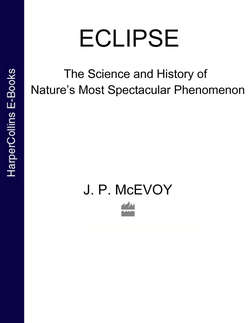Читать книгу Eclipse: The science and history of nature's most spectacular phenomenon - J. McEvoy P. - Страница 16
THE FUTURE OF THE TOTAL SOLAR ECLIPSE
ОглавлениеThe Renaissance astronomer Johannes Kepler was as impressed as anyone by the coincidence of the 400 : I distance/size ratio for the Sun and Moon. In fact, he called the solar eclipse ‘a gift to us from the Creator’. He also pointed out in one of his many studies of the heavens that this fortunate situation will not always be true. Millions of years from now, the size of the Moon’s orbit will have increased to the point where total solar eclipses won’t be possible. All central eclipses will be annular. Here is Kepler’s reasoning.
He calculated that when an object’s orbital speed increases, the size of its orbit expands. In the case of the Moon, its orbital speed increases as a result of tidal forces. The gravitational force of the Moon pulls on the Earth’s oceans and crust, creating the twice-daily tides. Likewise, the Earth’s gravity pulls on the Moon, and these tidal effects produce bulges on the Moon’s surface. However, the tidal bulges produced on the Earth by the Moon are not centred at the point on the Earth’s surface directly below the Moon, but are shifted ahead of the Moon because of Earth’s faster rate of spin. This is shown in Figure 1.11. So the tidal bulge on the Earth is dragged ahead of the Moon’s location in the sky. This bulge exerts an additional gravitational force on the Moon which has a component tending to increase the orbital speed. Over many years, this slight increase in the Moon’s orbital speed will cause the Moon to slowly recede from the Earth.
Figure 1.11. The effect of the Earth’s tidal bulge on the Moon’s orbital speed.
The effect of the Moon inching away from the Earth is barely noticeable on human timescales. But millions of years from now the effects will be real. Our distant descendants will never be able to view a total solar eclipse. At some point in the future the Moon’s diameter as seen from the Earth will always appear smaller than the Sun’s, and only annular eclipses will be possible. No doubt this has inspired many of the world’s obsessive eclipse-chasers who travel all over the world to view the extraordinary phenomenon of a total solar eclipse. They know how lucky we Homo sapiens are in the current epoch.
